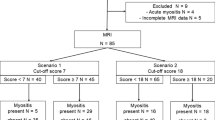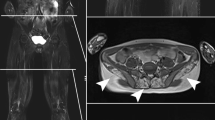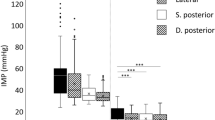Abstract
Objective. A prospective descriptive study to determine the value of magnetic resonance imaging (MRI) as an aid in diagnosing (chronic) exertional compartment syndrome.
Design and patients. MRI was performed in 21 patients (41 anterior compartments) with chronic compartment syndrome at rest and following physical exercise. Median (T2-weighted) signal intensity on the MRI scan was determined in the anterior and the (superficial) posterior compartment of the lower leg before and after exercise. Postexercise increases in the signal intensity in these two compartments were compared. After fasciotomy, a second MRI scan was performed in 13 patients (25 anterior compartments) on the basis of the same protocol. MR studies were performed in 12 normal controls (24 anterior muscle compartments) on the basis of the same protocol.
Results. T2-weighted signal intensity increased by 27.5% (range 13.6–38.6%) following exercise in the anterior compartment of patients with a chronic compartment syndrome. In the posterior compartment this increase amounted to 4.25% (range 0–10.2%). Following fasciotomy, the increase in the anterior compartment was 4.1% (range 1.0–5.2%), while the increase in the posterior compartment amounted to 5.6% (range 0–11.0%), In normal controls, the increase in the anterior compartment was 7.6% (range 0–9.1%), while in the posterior compartment it was 4.0% (range 0–7.2%).
Conclusions. In patients with a chronic compartment syndrome, the affected (anterior) compartment shows a statistically significant increase in (T2-weighted) signal intensity during exercise compared with both the (superficial) posterior compartment and the anterior compartment of normal controls. This effect disappeared after fasciotomy. In view of the substantial increase in T2-weighted signal intensity, MRI can be used in diagnosing chronic compartment syndrome.
Similar content being viewed by others
Author information
Authors and Affiliations
Additional information
Received: 23 October 2000 Revision requested: 5 December 2000 Revision received: 5 February 2001 Accepted: 19 February 2001
Rights and permissions
About this article
Cite this article
Verleisdonk, E., van Gils, A. & van der Werken, C. The diagnostic value of MRI scans for the diagnosis of chronic exertional compartment syndrome of the lower leg. Skeletal Radiol 30, 321–325 (2001). https://doi.org/10.1007/s002560100361
Issue Date:
DOI: https://doi.org/10.1007/s002560100361




